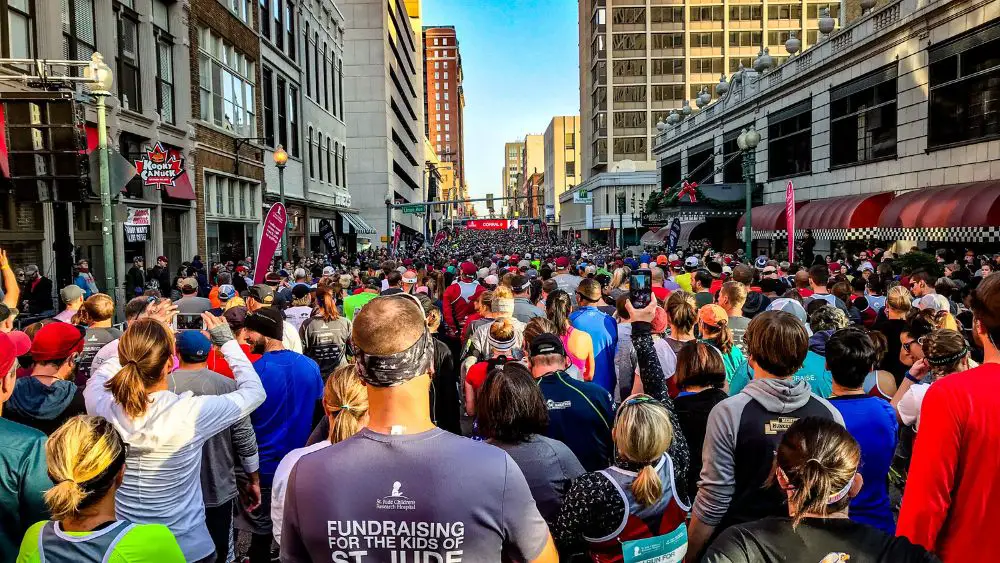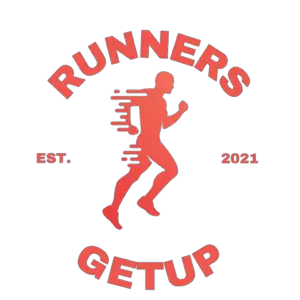This post contains affiliate links.

Marathon preparation is not limited to physical and mental training. It also involves choosing the equipment you will use. Your marathon might be on a hot, cold, or rainy day. Luckily, I am here to explain the best marathon gear to wear for all seasons.
Comfort and reliability should be your focus. Your summer, winter, and rainy gear must be ready to protect you from the harsh track. Let us focus on each of them:
Summer Marathon
With the scorching heat outside, your outfit must be focused on keeping your temperature regulated. Yes, it is common knowledge that running a marathon increases body heat to a few degrees. However, we can still take extra steps in keeping ourselves comfortable.
Moisture-free Top
One of the most notorious enemies that we will have during a summer marathon is humidity. It forces our body to sweat to keep up with the surrounding temperature. For men, it is recommended to make use of a quick-dry shirt that is a bit loose-fitting for air circulation.
Why do I suggest a shirt compared to a tank top? Well, this is because of added protection against the sun’s heat. Marathons take hours to finish, and an early morning start can turn into a mid-day battle.
A pro tip is to make use of nip guards to protect against the friction of the shirt. This is to avoid joggers’ nipples in the long run. Better to be safe than sorry!
For women, a breathable, sleeveless top can be beneficial for heat regulation. Not only that but they can also be layered over a sports bra for maximum comfort.
Recommended Gear: Under Armour Men’s Tech 2.0 Short-Sleeve T-Shirt
Comfy Shorts
The age-old battle between shorts and legging will never be finished. However, I prefer wearing shorts due to the comfort that they bring especially in summer events.
As stated earlier, the main goal of a summer marathon outfit is to maximize air circulation. Comfy shorts are a way to promote this since they give enough breathability for your legs and thighs. Make sure that what you purchase has quick-drying technology!
Recommended Gear: ASICS Men’s Rival Ii Short
Sunglasses and Headgear
Sunlight can be a pretty annoying factor to have around the race track. During summer, it might hit your face causing you to wince at every turn. Thus, having good sunglasses and headgear goes a long way.
The sunglasses must provide ample protection from UV rays. Also, it must diffuse entering light but not impeded vision. You don’t want to be fumbling around just because of your glasses.
Furthermore, your headgear has to be snug and fit around your forehead. Winds may come and go, and you want to avoid stopping just because your cap/visor fell off. Choose a well-ventilated one for airflow purposes!
Recommended Gear: goodr OG Sunglasses, Under Armour Men’s Performance Headband
Sunscreen
Never forget to apply sunscreen during race day! UV rays can even penetrate clouds and harm your skin in the long run. Having a water-resistant/sweat-resistant sunscreen is important.
You should be also aware of the right SPF levels for the best protection. As a rule of thumb, the higher the SPF, the better it is at blocking a percentage of UV Rays. Sadly, there is no way to completely block them.
Recommended Gear: Sport Sunscreen SPF 50
Hydration Pack
Summer means the need for more water! Hydration is key for marathoners who will try to go past their limits. Thus, having a belt that can house your water container is important for any runner. Make sure that it does not move/bounce much when running so that your performance is not affected.
Recommended Gear: Nathan Running Belt
Summer Running Shoes and Socks
Summer running shoes must be breathable and well-regulated. You do not want your feet to be scorched by the asphalt you’re running in. As such, choose a model your feet are cozy with. Always stick to the same shoes that you trained on as it will have benefits during race day.
For socks, opting for thin ones is highly suggested. Stay away from cotton as it absorbs water quickly and might be the source of icky, smelly feet.
Recommended Gear: Brooks Ghost 14
Rainy Marathon
Rainy marathons are a bit tricky. It has many subcategories such as mere drizzles, torrential rains, and even downpours. Thus, having the perfect gear to protect you against it is important. Here are some suggestions on what gear to wear on rainy days:
Layered Top
Your outermost layer should provide some fight against wind and rain elements. This can be in the form of a light waterproof jacket. Refrain from using water absorbing materials like cotton or other variations as it will result in heavier clothes.
Synthetic materials that are still comfy that don’t add up weight are nodded upon.
Your innerwear must be a tight-fit shirt or tank top. Women may also wear sports bras provided that they have added layers for protection. Compared to sunny gear which is loose-fitting, rainy wear must be tight to the skin to provide ample heating.
Since water might cause friction, don’t forget to apply anti-chaffing material to areas that may experience pain.
Recommended Gear: Brooks Men’s Canopy Jacket, Under Armour Men’s HeatGear Compression, Champion Spot Comfort Sports Bra
Why Layer?
Layering clothes have added benefits in terms of quick modification. For example, once your body heats up during the run, you can simply remove one layer to keep yourself comfortable. Compared to wearing a single bulk of thick clothing, you get more freedom of choice.
Shorts vs. Leggings
When rain is not that hard or just drizzling, I recommend wearing fitted shorts that do not give room for friction. Tights or spandexes help in this.
However, if rain is harder than usual, running leggings are my go-to companions. This help achieve comfort and heat regulation compared to shorts. As usual, you should go for anti-moisture material that does not soak up water.
Recommended Gear: Under Armour Men’s HeatGear Long Shorts, New Balance Men’s Impact Run Tight
Brimmed Cap/Hat
If there’s one thing that annoys me during running in the rain, it is the water droplets hitting my face. I tend to lose focus when experiencing this. Thus, I opted to buy a brimmed cap that is also moisture-wicking to prevent it from happening.
Recommended Gear: NIKE AeroBill Featherlight Cap
Shoes with Good Grip
Rain always equates to a wet road which in turn equates to a slippery trail. With this in mind, getting shoes with an extra grip on the sole can help you keep safe.
This is especially important in uphill running where gravity goes against you. Also, getting socks that are free from moisture is a good tandem with your shoes.
Recommended Gear: Brooks Ghost 14 Sneakers
Winter Marathon
Winter marathons are one of the harshest weather. You need to be prepared for the cold as well as the snowy track. Here are some things to prepare for it:
Layering and Insulation
Your topmost layer must be focused on three things. A base with wicking properties, an insulation layer to fight against the cold, and a windbreaker layer to combat elements of rain and wind.
For the base, having thigh DryFit technology is recommended. For insulation, a simple fleece-lined long sleeves can go a long way. Lastly, the outer layer must protect against outdoor elements such as wind and snow.
Recommended Gear: Columbia Men’s Delta Ridge Down Jacket
Lower Wear
Similar to the top wear, your lower body must have ample protection against cold. Thus, tight running pants are highly suggested. Similar to previous clothing, making use of anti-moisture and heat-trapping material is very recommended. In worst-case scenarios, you might want to layer up with running trousers.
A pro tip is to wear brightly-colored clothes so that cars and motorcycles can spot you. This is because visibility is very limited during winter and snow. Yellow, orange, or red outfits with reflective properties help a lot.
Recommended Gear: Under Armour Women’s Fly Fast 2.0 ColdGear
Gloves and Headgear
Having the correct gloves and headgear can protect you from freezing temperatures. Thus, it is recommended to have either a heat-retaining beenie or ear warmers.
Wool is the material to choose for these gears. They prevent moisture from seeping in while keeping your hand and head warm.
A bandana can also look and feel good for your gear. This aids in proper air circulation especially due to the cold air.
Recommended Gear: Under Armour Men’s Armour Liner 2.0 Gloves, Minus33 Ridge Cuff Beanie
Shoes and Socks
Winter shoes will vary greatly on the terrain. For steep and snow-covered ones, hiking/trail shoes that are comfy could prove to be a good idea. However, for light snow on the surface, your regular shoes will do.
Keep in mind to use moisture-wicking socks such as wool and polyester materials for optimal performance. They will keep your temperature regulated and remove annoyances due to defrosted snow.
Recommended Gear: Salomon Sense ride 4, Smartwool Socks
Running Vest
Running in winter has its fair share of dangers. Thus, having a running vest equipped with emergency gear is important. You can stash your medical info, some light first-aid materials, and even your phone in it. Also, it can be a source of lukewarm water that may get you relief.
Choose a running vest that is snug on the body and stores your things securely.
Recommended Gear: Nathan VaporAir
If you want to learn more about what to wear when running in winter, I highly recommend you read this article that I made (link above).
I’ve broken down different layerings based on the winter temperature from a relatively warm 50-60 degrees to below-freezing temperatures.
Final Thoughts
Now that you are aware of the marathon gear to have during the summer, winter, and rainy seasons, you will be ready to take on the challenge of finishing the race. Remember that your gear will always be based on your preference and capability as a runner. Keep safe and be ready for the challenges that the trail may bring!
Read Next: Marathon Checklist: 12 Things to Pack for Race Day

